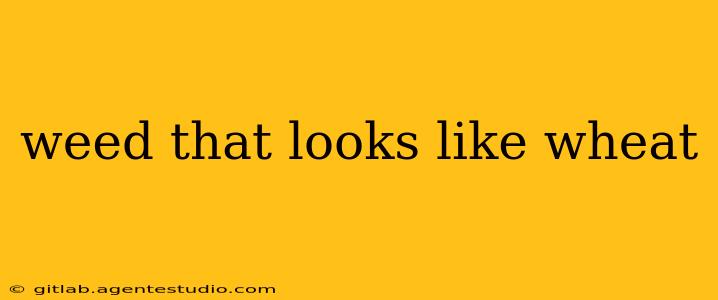Wheat is a vital global crop, and its similarity to certain weeds can lead to significant yield losses and challenges in maintaining crop purity. This comprehensive guide will help you identify weeds commonly mistaken for wheat and discuss effective management strategies. Knowing how to distinguish these imposters is crucial for successful farming and maintaining the quality of your wheat harvest.
Common Weeds Mistaken for Wheat
Several weeds exhibit characteristics that mimic wheat, making identification tricky, especially in early growth stages. Here are some of the most prevalent culprits:
1. Downy Brome (Bromus tectorum)
- Distinguishing Features: Downy brome is an annual grass with a hairy appearance, particularly noticeable on the leaf sheaths. Its seed heads are more open and spreading than wheat, and the individual seeds are longer and awned (with a bristle-like appendage).
- Impact: Downy brome competes aggressively with wheat for resources, reducing yields and potentially contaminating harvested grain.
2. Cheatgrass (Bromus secalinus)
- Distinguishing Features: Cheatgrass, like downy brome, is an annual grass. However, it tends to have a slightly smoother texture than downy brome. Its seed heads are typically more compact and erect than downy brome but less so than wheat. A key difference lies in the seeds: cheatgrass seeds are noticeably larger than wheat seeds.
- Impact: Cheatgrass can significantly reduce wheat yields and can be difficult to remove completely once established.
3. Wild Oats (Avena fatua)
- Distinguishing Features: Wild oats are another annual grass weed. They're easily distinguished by their characteristic twisted awns on the seeds, which are significantly larger than wheat seeds. The leaves are wider and flatter than wheat leaves.
- Impact: Wild oats are highly competitive, reducing wheat yields and affecting grain quality. Their seeds can remain viable in the soil for many years.
4. Barnyardgrass (Echinochloa crus-galli)
- Distinguishing Features: Barnyardgrass is an annual broadleaf weed that differs significantly in leaf structure from wheat. The leaves are wider and have a more pronounced midrib. This weed also produces a different seedhead structure.
- Impact: Barnyardgrass is highly competitive, especially in irrigated fields, and can reduce wheat yields substantially.
Effective Weed Management Strategies
Controlling weeds that mimic wheat requires a multifaceted approach that integrates several methods:
1. Prevention:
- Clean Seed: Using certified weed-free seed is crucial to prevent the introduction of weed seeds into your fields.
- Crop Rotation: Rotating crops can help disrupt the weed lifecycle and reduce weed populations.
2. Cultural Control:
- Tillage: Proper tillage practices can help bury weed seeds, reducing their germination. However, this isn't always sustainable or environmentally friendly.
- Competition: Healthy wheat stands can effectively compete with some weeds for resources.
3. Chemical Control:
- Herbicides: Pre-emergent and post-emergent herbicides are available to control specific weed species. Always follow label instructions carefully and choose herbicides appropriate for your region and wheat variety.
4. Integrated Pest Management (IPM):
IPM is a sustainable approach that combines various control methods to minimize weed infestations while preserving environmental health. This approach emphasizes careful monitoring, using the least toxic methods first, and tailoring strategies to specific weed species and field conditions.
Conclusion
Successfully identifying and managing weeds that resemble wheat requires diligent observation, accurate identification, and a well-planned control strategy. By utilizing a combination of preventative measures, cultural practices, and chemical control, farmers can significantly minimize the impact of these unwanted plants on their wheat crop and safeguard their yields. Always consult local agricultural extension services for specific recommendations and up-to-date information regarding weed control in your area.

